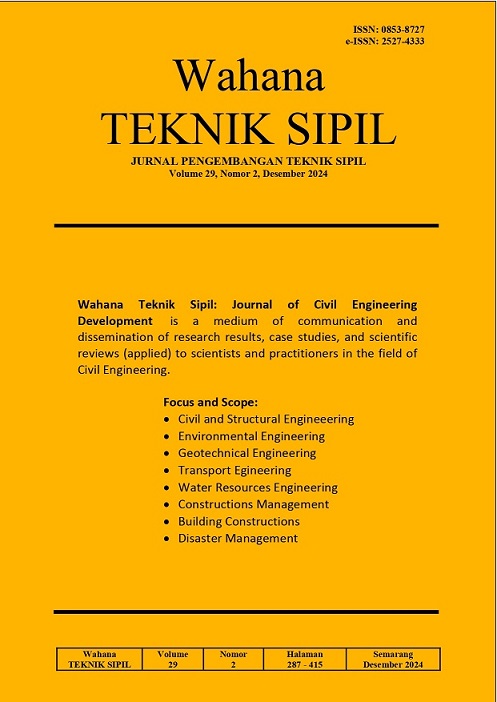EKSPLORASI DAMPAK PERUBAHAN MANUAL DESAIN PERKERASAN JALAN (MDPJ) 2017 KE 2024 MENGGUNAKAN PROGRAM KENPAVE
DOI:
https://doi.org/10.32497/wahanats.v29i2.6232Keywords:
MDPJ 2017, MDPJ 2024, KENPAVEAbstract
his study explores the impact of changes in the Manual for Pavement Design (MDPJ) from the 2017 edition to the 2024 edition, published by the Directorate General of Highways (DJBM) in May 2024, using the same secondary data as a comparative approach. The secondary data used in this research is from the Prambanan ”“ Piyungan road section in 2023. This exploration is considered crucial to identify how modifications in the latest design guidelines may influence the final outcomes in road planning, particularly in pavement performance.Using the KENPAVE program, the performance comparison between the two pavement designs is assessed based on predicted vulnerability levels to rutting (Nr), fatigue cracking (Nf), and permanent deformation (Nd). The first predicted failure value is then selected and used as a reference in this study. The comparative analysis results (based on the current study”™s secondary data) indicate that pavement design based on MDPJ 2024 has a lower vulnerability value than MDPJ 2017, with a percentage difference of 5.5%. This study confirms that the updates in the latest design guidelines contribute to improving pavement performance. The findings of this research are expected to support the effective and sustainable implementation of MDPJ 2024 in Indonesia.References
Abdulmawjoud, A.A., Younis, N., & Khlil, A., 2022, Prediction of Fatigue and Rutting Premature Distress In Viscoelastic Flexible Pavement Layered For Different Loading Condition Using Mechanistic-Empirical Method. Association of Arab Universities Journal of Engineering Sciences, 29 (1), 79-87.
Alkaissi, Z.A., 2020, Effect of high temperature and traffic loading on rutting performance of flexible pavement. Journal of King Saud University-Engineering Sciences, 32 (1), 1-4.
Burnos, P., Gajda, J., Sroka, R., Wasilewska, M., & Dolega, C., 2021, High accuracy weigh-inmotion systems for direct enforcement. Sensors, 21 (23), 8046.
Dinata, D.I., Rahmawati, A., & Setiawan, D., 2017, Evaluasi tebal perkerasan lentur dengan metode analisa komponen dari Bina Marga 1987 dan metode AASHTO 1993 menggunakan program KENPAVE (studi kasus: jalan karangmojosemin sta 0+ 000 sampai sta 4+050). Semesta Teknika, 20 (1), 8-19.
Direktorat Jenderal Bina Marga, 2013, Manual Desain Perkerasan Jalan (MDPJ) 2013. Kementerian Pekerjaan Umum dan Perumahan Rakyat, Indonesia.
Direktorat Jenderal Bina Marga, 2017, Manual Desain Perkerasan Jalan (MDPJ) 2017. Kementerian Pekerjaan Umum dan Perumahan
Rakyat, Indonesia.
Direktorat Jenderal Bina Marga, 2024, Manual Desain Perkerasan Jalan (MDPJ) 2024. Kementerian Pekerjaan Umum dan Perumahan Rakyat, Indonesia.
Hadi, M.A., 2023, Identifikasi Kerentanan Kinerja Perkerasan Jalan Terhadap Aktivitas Overload Kendaraan Menggunakan Program KENPAVE. Siklus: Jurnal Teknik Sipil, 9 (2), 95-104
Hadi, M.A., & Fauziah, M., 2022, Studi komparasi prediksi umur pelayanan antara campuran Superpave dan AC-WC menggunakan permodelan viskoelastik dan elastik. Teknisia, 27 (2), 71-82.
Huang, Y.H., 1993, Pavement analysis and design. Prentice Hall, 100 ”“167.
Lau, Y.S., Subagio, B.S., & Hendarto, S., 2019, Overlay Thickness of
Flexible Pavement Analysis Using the Austroad 2010 Method and The Kenpave Program. Case
Study: CIPALI (CikopoPalimanan) Toll Road. Journal 0f Civil Engineering, 26 (1).
Lee, J., & Kim, S., 2020, Comparative Evaluation of Pavement Design
Policies. Journal of Infrastructure Systems, 26 (1), 10-22.
Liu, Y., Su, P., Li, M., You, Z., & Zhao, M., 2020, Review on Evolution and Evaluation of Asphalt Pavement Structures and Materials. Journal of Traffic and Transportation Engineering (English Edition), 7 (5), 573-599.
Loudon, N., & Horsfield, D., 2021, Updating Highways England's Structures Standards”“an Overview. In Proceedings of the Institution of Civil Engineers-Bridge Engineering 174 (3), 160-175.
Marlina, E., Frans, J.H., & Nasjono, J.K., 2023, Analisis Tebal Perkerasan Lentur dengan Metode Bina Marga 2017 dan Program
Kenpave. Jurnal Teknik Sipil, 12 (2), 173-184.
Mishra, A., & Patel, D., 2019, Analysis of structural Deformation in
Flexible Pavement Using KENLAYER Programme. International Research Journal of Engineering and Technology, 6 (8), 1168-1173.
Norouzi, A., Kim, D., & Richard Kim, Y., 2016, Numerical Evaluation of Pavement Design Parameters For The Fatigue Cracking and Rutting Performance of Asphalt Pavements. Materials and Structures, 49, 3619-3634.
Rind, T.A., Jhatial, A.A., Sandhu, A.R., Bhatti, I.A., & Ahmed, S., 2019, Fatigue and Rutting Analysis Of Asphaltic Pavement Using “KENLAYER” Software. Journal of Applied Engineering Sciences, 9(2), 177-182.
Rys, D., Judycki, J., & Jaskula, P., 2016, Analysis of axle loadings and determination of vehicle damage factor for flexible pavements. International Journal of Pavement Engineering, 17 (8), 1-12.
Sjarief, R.O., Iskandar, T., & Mulyadi, L., 2018, Analisa Pembengkakan Biaya Pelaksanaan Proyek-Proyek Pembangunan/Pemeliharaan Jalan Di Kabupaten Probolinggo. INFOMANPRO, 7 (1), 1-14.
Sunil, R.K., Manjunatha, S., Kiran, K., & Praveen, S.P.K., 2014, Analysis of Axle Loadings and Determination of Vehicle Damage Factor and Design of Overlay on Outer Ring Road in Bangalore, Karnataka. International Journal for Scientific Research & Development. 2 (9), 709-712.
Tajudin, A.N., & Winarko, C.G.A., 2020, Flexible Pavement Mechanistic
Response to the 2017 Indonesian Road Pavement Manual with
Cement-Treated Base (CTB). In IOP Conference Series: Materials
Science and Engineering. 852 (1).
Zhang, Q.S., Chen, Y.L., & Li, X.L., 2009, Rutting in asphalt pavement under heavy load and high temperature. In Asphalt material characterization, accelerated testing, and highway management: Selected papers from the 2009 GeoHunan International Conference (pp. 39-48).
Downloads
Published
Issue
Section
License
Authors who publish with this journal agree to the following terms:Authors retain copyright and grant the journal right of first publication with the work simultaneously licensed under a Creative Commons Attribution License that allows others to share the work with an acknowledgement of the work's authorship and initial publication in this journal.
Authors are able to enter into separate, additional contractual arrangements for the non-exclusive distribution of the journal's published version of the work (e.g., post it to an institutional repository or publish it in a book), with an acknowledgement of its initial publication in this journal.
Authors are permitted and encouraged to post their work online (e.g., in institutional repositories or on their website) prior to and during the submission process, as it can lead to productive exchanges, as well as earlier and greater citation of published work (See The Effect of Open Access).






